Lalanne C. Mechanical Vibrations and Shocks: Mechanical Shock Volume II
Подождите немного. Документ загружается.

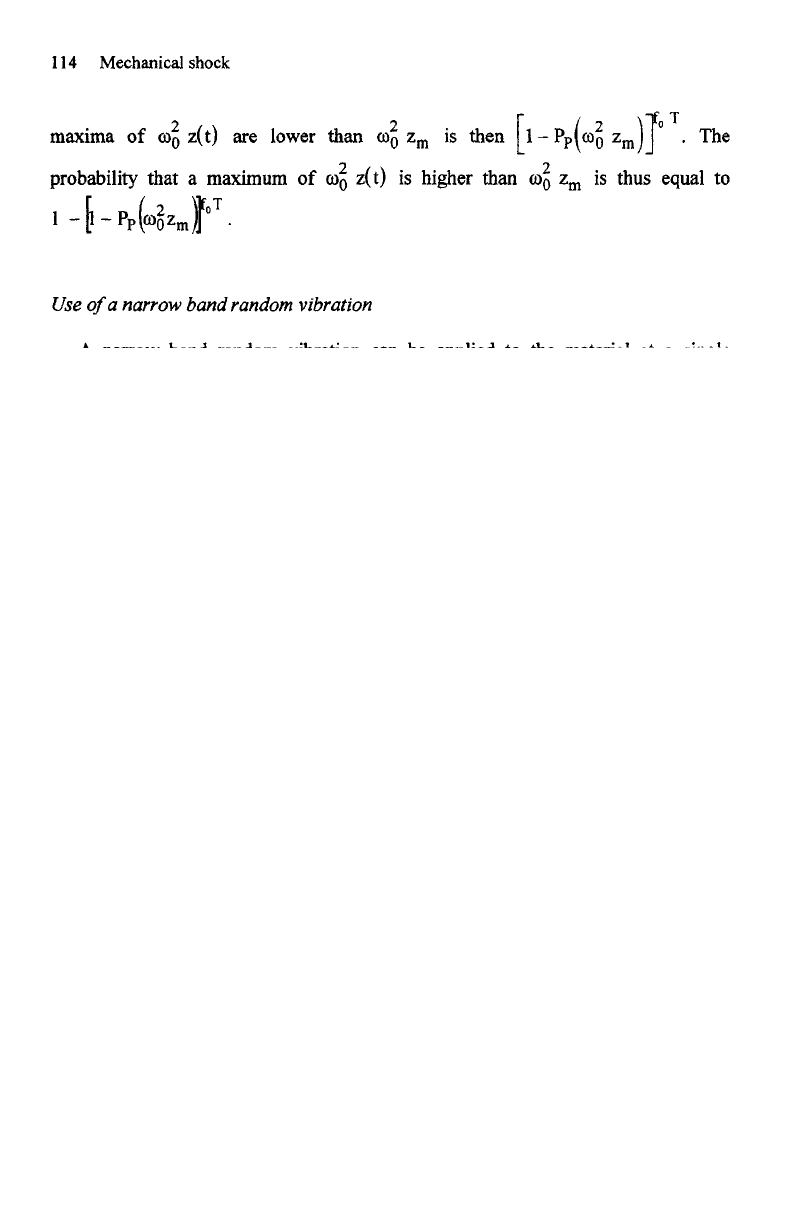
114
Mechanical shock
0 "7 I / "7 \ rO
maxima
of w
0
2
z(t)
are
lower than
w
0
2
z
m
is
then
1-P
p
(w
0
2
z
m
) . The
probability that
a
maximum
of
O>Q
z(t)
is
higher than
w
0
2
z
m
is
thus equal
to
i4-4fo-F-
Use of a
narrow band random vibration
A
narrow band random vibration
can be
applied
to the
material
at a
single
frequency or
several
frequencies
simultaneously. This
process
has
some advantages
[KER 84]:
- the
number
of
cycles exceeding
a
given level
can be
limited;
-
several resonances
can
be
excited simultaneously;
-
amplification
at
resonance
is
reduced compared
to the
slow swept sine (the
response varies
as /Q
instead
of Q).
But
the
nature
of the
vibration does
not
make
it
possible
to
ensure
the
reproducibility
of the
test.
4.4.5.
Least favourable response technique
Basic assumption
It
is
supposed
that
the
Fourier spectrum (amplitude)
is
specified, which
is
equivalent
to
specifying
the
undamped residual shock spectrum (Section
3.8.2.).
It is
shown that
if the
transfer
function
between
the
input
and the
response
of the
test
item (and
not
that
of the
shaker)
can be
characterized
by:
then
the
peak response
of the
structure will
be
maximized
by the
input [SMA 74a]
[SMA 75]:
where X
e
(Q)
is the
module
of the
specified Fourier transform
and
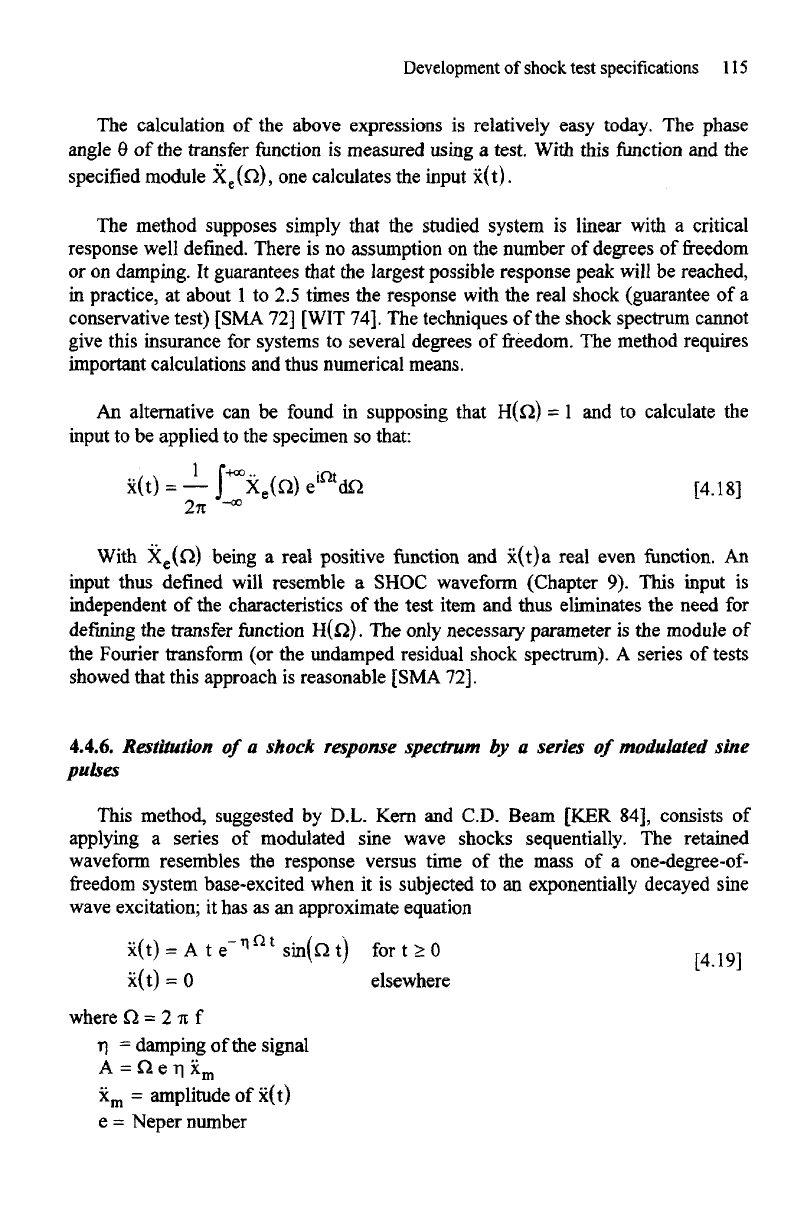
Development
of
shock
test
specifications
115
The
calculation
of the
above expressions
is
relatively easy today.
The
phase
angle
6 of the
transfer function
is
measured using
a
test.
With this function
and the
specified
module X
e
(Q),
one
calculates
the
input x(t).
The
method supposes simply that
the
studied system
is
linear with
a
critical
response well
defined.
There
is no
assumption
on the
number
of
degrees
of freedom
or on
damping.
It
guarantees that
the
largest
possible
response
peak will
be
reached,
in
practice,
at
about
1 to 2.5
times
the
response with
the
real shock (guarantee
of a
conservative test) [SMA
72]
[WIT 74].
The
techniques
of the
shock spectrum cannot
give
this insurance
for
systems
to
several degrees
of freedom. The
method requires
important calculations
and
thus numerical means.
An
alternative
can be
found
in
supposing that H(Q)
= 1 and to
calculate
the
input
to be
applied
to the
specimen
so
that:
4.4.6.
Restitution
of a
shock response spectrum
by a
series
of
modulated sine
pulses
This method, suggested
by
D.L. Kern
and
C.D. Beam [KER 84], consists
of
applying
a
series
of
modulated sine wave shocks sequentially.
The
retained
waveform
resembles
the
response versus time
of the
mass
of a
one-degree-of-
freedom
system base-excited when
it is
subjected
to an
exponentially decayed sine
wave
excitation;
it has as an
approximate equation
where
Q = 2 n f
T]
=
damping
of the
signal
A
= Q e T| x
m
x
m
=
amplitude
of
x(t)
e =
Neper number
elsewhere
With
X
e
(Q) being
a
real positive
function
and
x(t)a real even
function.
An
input thus defined will resemble
a
SHOC waveform (Chapter
9).
This input
is
independent
of the
characteristics
of the
test
item
and
thus eliminates
the
need
for
defining
the
transfer function H(Q).
The
only
necessary
parameter
is the
module
of
the
Fourier transform
(or the
undamped residual shock spectrum).
A
series
of
tests
showed
that this approach
is
reasonable [SMA 72].
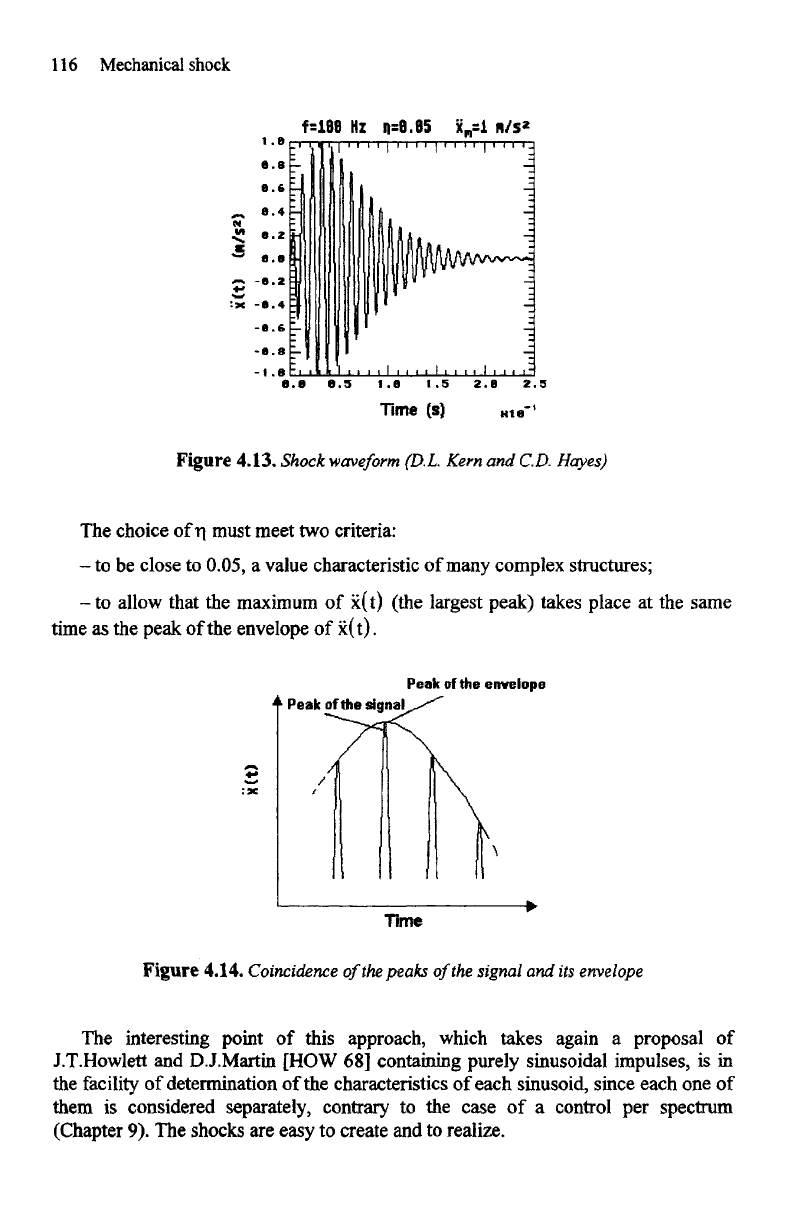
116
Mechanical shock
Figure 4.14.
Coincidence
of
the
peaks
of
the
signal
and its
envelope
The
interesting point
of
this approach, which takes again
a
proposal
of
J.T.Howlett
and
D.J.Martin [HOW
68]
containing purely sinusoidal impulses,
is in
the
facility
of
determination
of the
characteristics
of
each sinusoid, since each
one of
them
is
considered separately, contrary
to the
case
of a
control
per
spectrum
(Chapter
9). The
shocks
are
easy
to
create
and to
realize.
Figure
4.13.
Shock
waveform
(D.L
Kern
and CD.
Hayes)
The
choice
of
r\
must
meet
two
criteria:
- to be
close
to
0.05,
a
value characteristic
of
many
complex structures;
- to
allow that
the
maximum
of
x(t) (the largest peak) takes place
at the
same
time
as the
peak
of the
envelope
of
x(t).
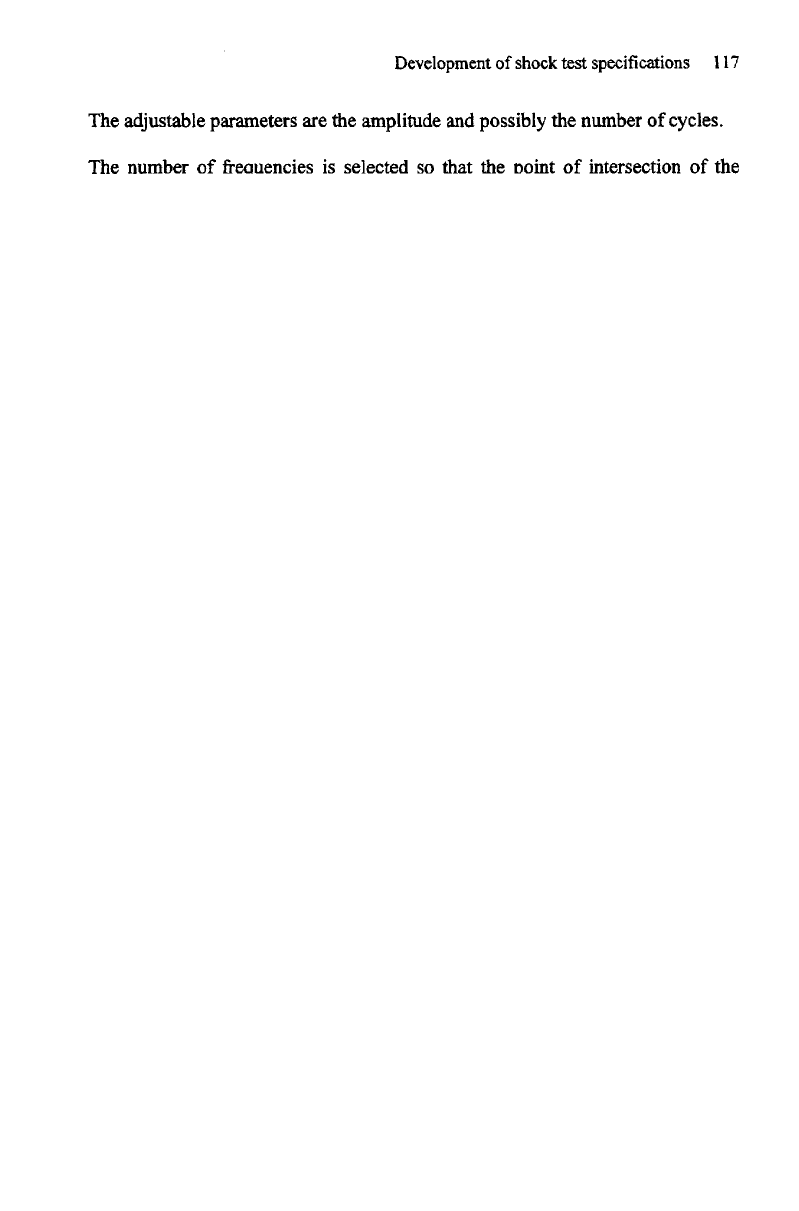
Development
of
shock
test
specifications
117
The
adjustable parameters
are the
amplitude
and
possibly
the
number
of
cycles.
The
number
of
frequencies
is
selected
so
that
the
point
of
intersection
of the
spectra
of two
adjacent signals
is not
lower
by
more than
3 dB
than
the
amplitude
of
the
peak
of the
spectrum (plotted
for a
damping equal
to
0.05). Like
the
slowly
swept sine, this method does
not
make
it
possible
to
excite
all
resonances
simultaneously.
We
will
see in
Chapter
9 how
this waveform
can be
used
to
constitute
a
complex
drive
signal restoring
the
whole
of the
spectrum.
4.5. Interest behind simulation
of
shocks
on a
shaker using
a
shock spectrum
The
data
of a
shock specification
for a
response spectrum
has
several advantages:
- the
response spectrum should
be
more easily exploitable
for
dimensioning
of
the
structure than
the
signal x(t) itself;
-
this spectrum
can
result directly
from
measurements
of the
real environment
and
does
not
require,
at the
design
stage
to
proceed
to an
often
delicate equivalence
with
a
signal
of
simple shape;
- the
spectrum
can be
treated
in a
statistical
way if one has
several measurements
of
the
same phenomenon,
it can be the
envelope
of
several
different
transitory events
and
can be
increased
by a
uncertainty coefficient;
-the reference most commonly allowed
to
judge quality
of the
shock simulation
is
comparison
of the
response spectra
of the
specification with
the
shock carried out.
In
a
complementary way, when
the
shock
tests
can be
carried
out
using
a
shaker,
one
can
have direct control
from a
response spectrum:
- The
search
for a
simple
form
shock
of a
given spectrum compatible with
the
usual
test
facilities
is not
always
a
simple operation, according
to the
shape
of the
reference
spectrum resulting
from
measurements
of the
real environment.
- The
shapes
of the
specified
spectra
can be
very varied, contrary
to
those
of the
spectra
of the
usual shocks (half-sine, triangles,
rectangles
etc) carried
out on the
shock machines.
One can
therefore improve
the
quality
of
simulation
and
reproduce
shocks
difficult
to
simulate with
the
usual means
(case
of the
pyroshocks
for
example)
[GAL
73] and
[ROT 72].
-
Taking into account
the
oscillatory nature
of the
elementary signals used,
the
positive
and
negative spectra
are
very close, which makes
a
reversal
of the
test
item
[PAI
64]
useless.
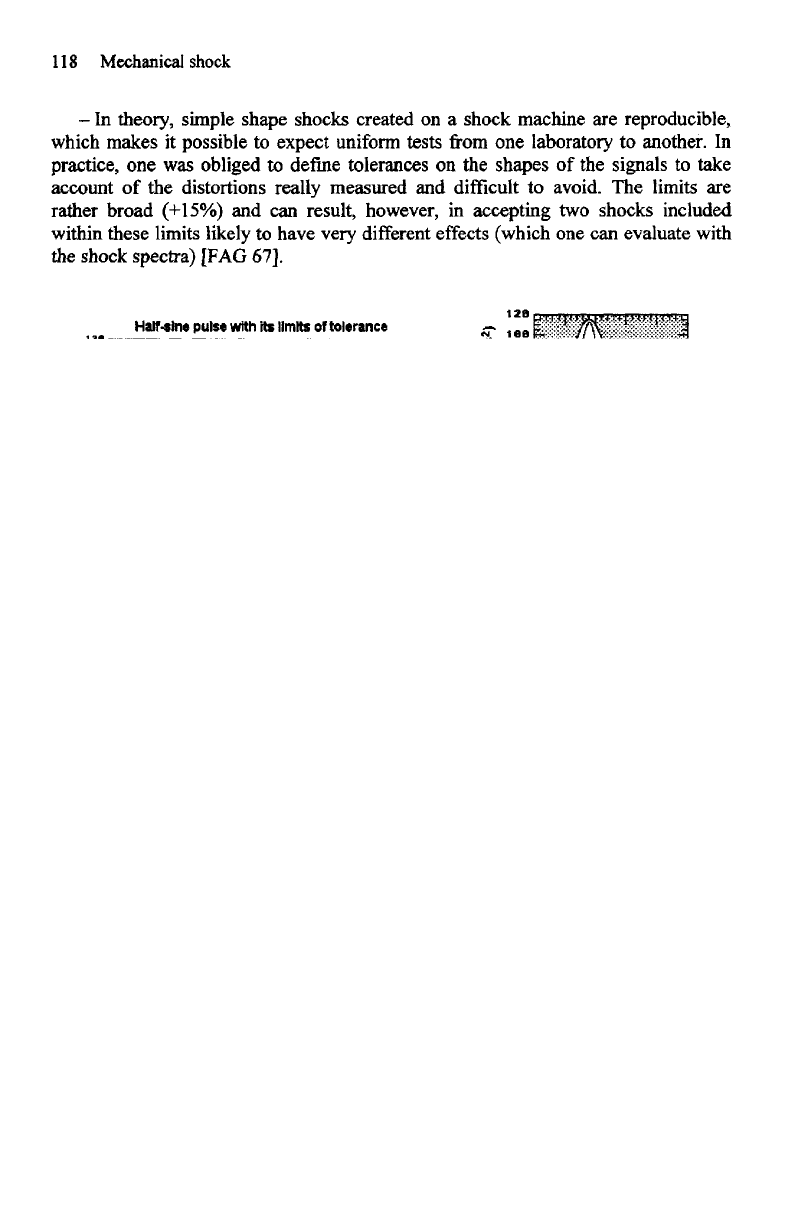
118
Mechanical
shock
- In
theory, simple shape shocks created
on a
shock machine
are
reproducible,
which
makes
it
possible
to
expect
uniform
tests
from one
laboratory
to
another.
In
practice,
one was
obliged
to
define tolerances
on the
shapes
of the
signals
to
take
account
of the
distortions really measured
and
difficult
to
avoid.
The
limits
are
rather
broad (+15%)
and can
result, however,
in
accepting
two
shocks included
within
these limits likely
to
have very
different
effects
(which
one can
evaluate with
the
shock
spectra)
[FAG
67].
Figure 4.17.
SRS
of
the
nominal
half-sine
and the
tolerance limits
Figures
4.15
and
4.17 show
as an
example
a
nominal half-sine
(100 m/s
2
,
10 ms)
and
its
tolerance
limits,
as
well
as the
shock
spectra
of the
nominal
shock
and
each
lower
and
upper limit. Figure
4.16
represents
a
shock made
up of the sum of the
nominal
half-sine
and of a
sinusoid
of
amplitude
15
m/s
2
and frequency
2500
Hz.
Figure 4.15.
Nominal
half-sine
and its
tolerances
Figure 4.16.
Shock located
between
the
tolerances
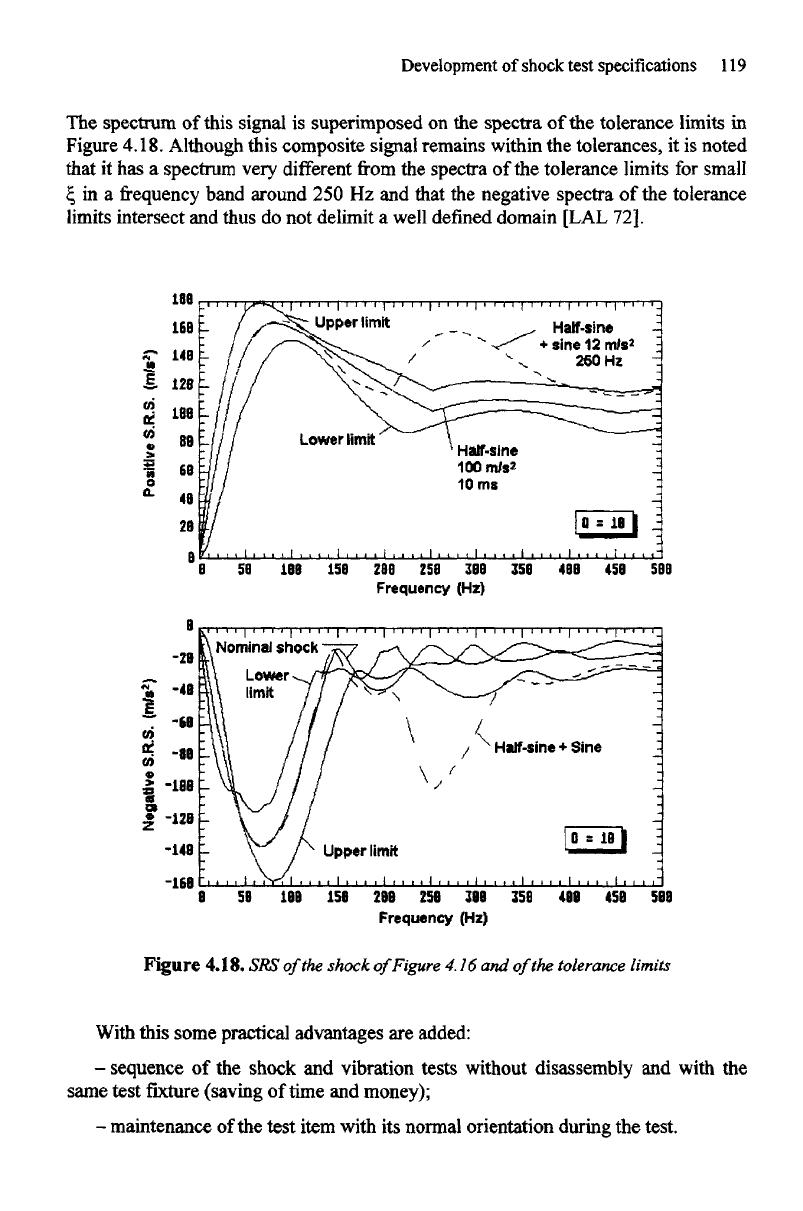
Development
of
shock
test
specifications
119
The
spectrum
of
this signal
is
superimposed
on the
spectra
of the
tolerance limits
in
Figure 4.18. Although this composite signal remains within
the
tolerances,
it is
noted
that
it has a
spectrum very
different
from the
spectra
of the
tolerance limits
for
small
£,
in a frequency
band around
250 Hz and mat the
negative spectra
of the
tolerance
limits
intersect
and
thus
do not
delimit
a
well defined domain [LAL 72].
Figure 4.18.
SRS
of
the
shock
of
Figure
4.16
and
of
the
tolerance limits
With
mis
some
practical
advantages
are
added:
-
sequence
of the
shock
and
vibration
tests
without disassembly
and
with
the
same
test
fixture (saving
of
time
and
money);
-
maintenance
of
the
test
item with
its
normal orientation during
the
test.
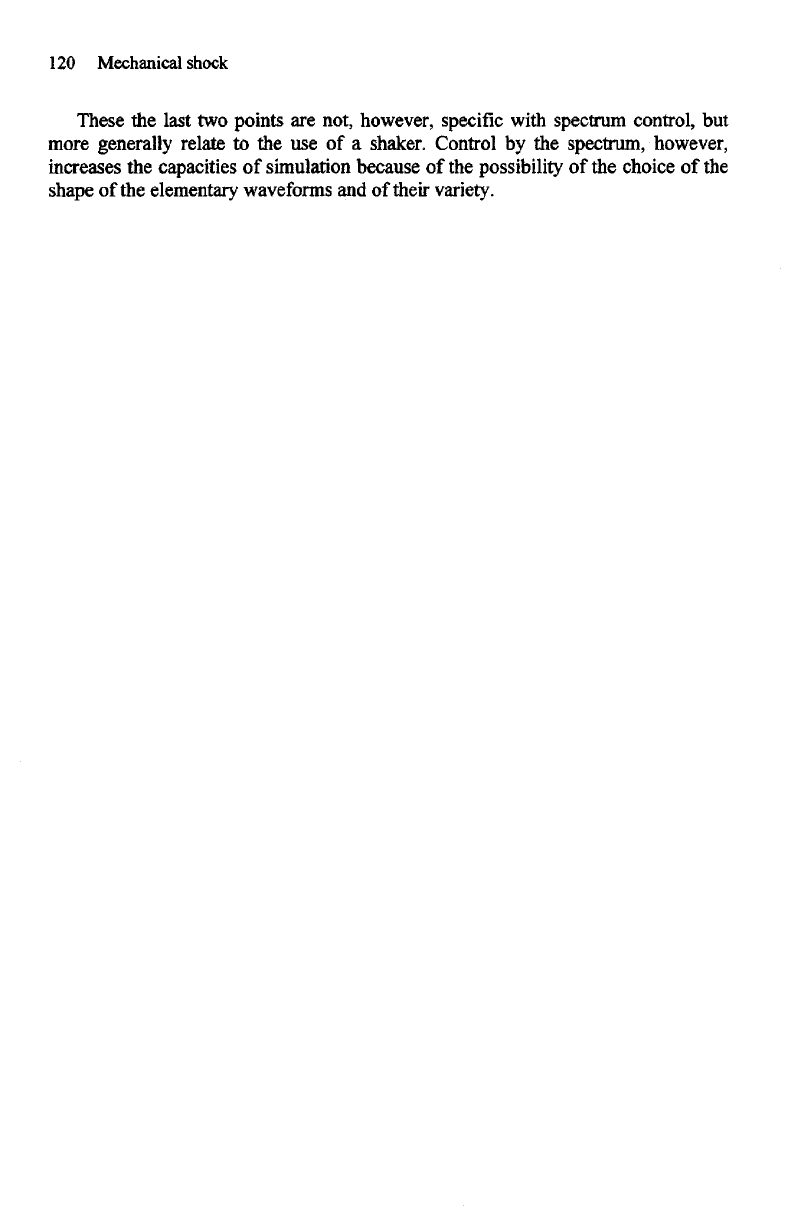
120
Mechanical shock
These
the
last
two
points
are
not, however, specific with spectrum control,
but
more generally relate
to the use of a
shaker. Control
by the
spectrum, however,
increases
the
capacities
of
simulation
because
of the
possibility
of the
choice
of the
shape
of the
elementary waveforms
and of
their variety.
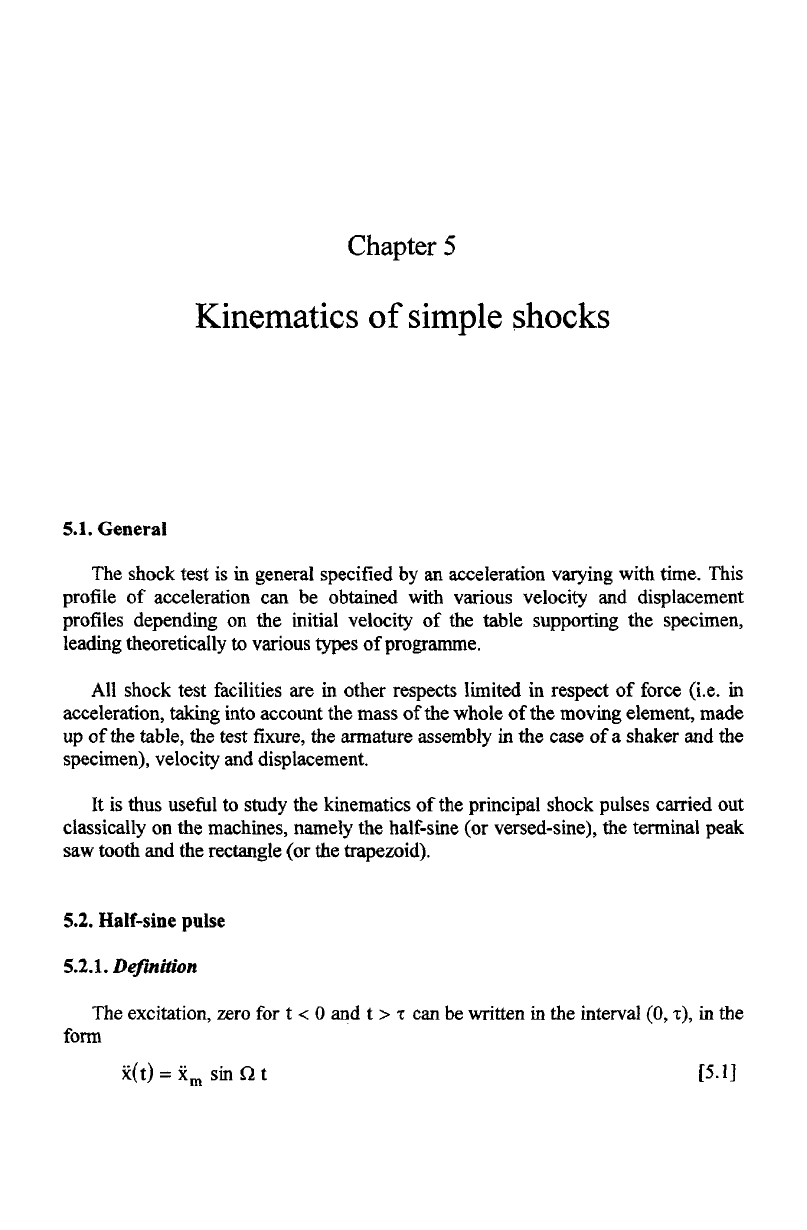
Chapter
5
Kinematics
of
simple shocks
5.1.
General
The
shock
test
is in
general specified
by an
acceleration varying with time. This
profile
of
acceleration
can be
obtained with various velocity
and
displacement
profiles
depending
on the
initial velocity
of the
table supporting
the
specimen,
leading
theoretically
to
various types
of
programme.
All
shock test
facilities
are in
other respects limited
in
respect
of
force (i.e.
in
acceleration, taking into account
the
mass
of the
whole
of the
moving element, made
up
of the
table,
the
test
fixure, the
armature assembly
in the
case
of a
shaker
and the
specimen), velocity
and
displacement.
It
is
thus
useful
to
study
the
kinematics
of the
principal shock pulses carried
out
classically
on the
machines, namely
the
half-sine
(or
versed-sine),
the
terminal peak
saw
tooth
and the
rectangle
(or the
trapezoid).
5.2. Half-sine pulse
5.2.1.
Definition
The
excitation, zero
for t < 0 and t > T can be
written
in the
interval
(0, T), in the
form
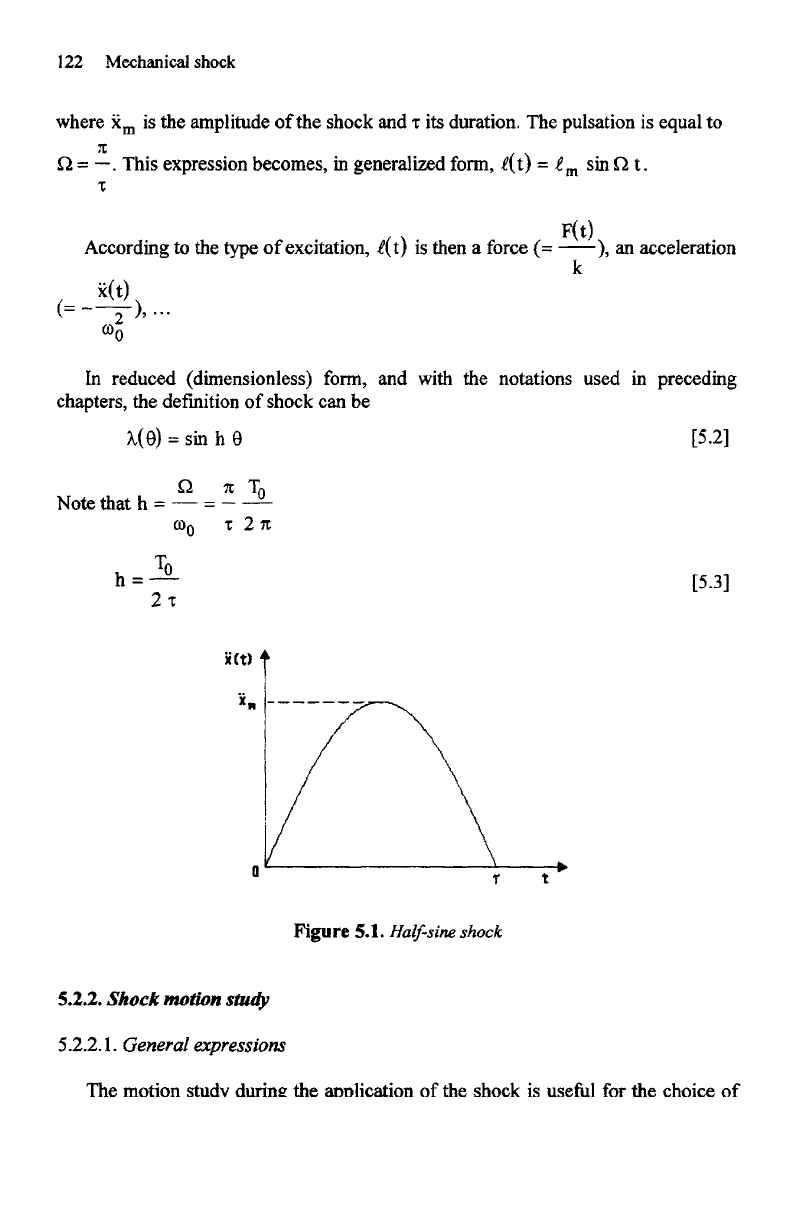
122
Mechanical shock
where
x
m
is the
amplitude
of the
shock
and T its
duration.
The
pulsation
is
equal
to
This expression becomes,
in
generalized
form,
l(t)
= l
m
sin Q t.
According
to the
type
of
excitation, l(t)
is
then
a
force
an
acceleration
In
reduced
(dimensionless)
form,
and
with
the
notations used
in
preceding
chapters,
the
definition
of
shock
can be
Note that
h
Figure
5.1.
Half-sine
shock
5.2.2.
Shock motion
study
5.2.2.1.
General
expressions
The
motion study during
the
application
of the
shock
is
useful
for the
choice
of
the
programmer
and the
test
facility which
will
make
it
possible
to
carry
out the
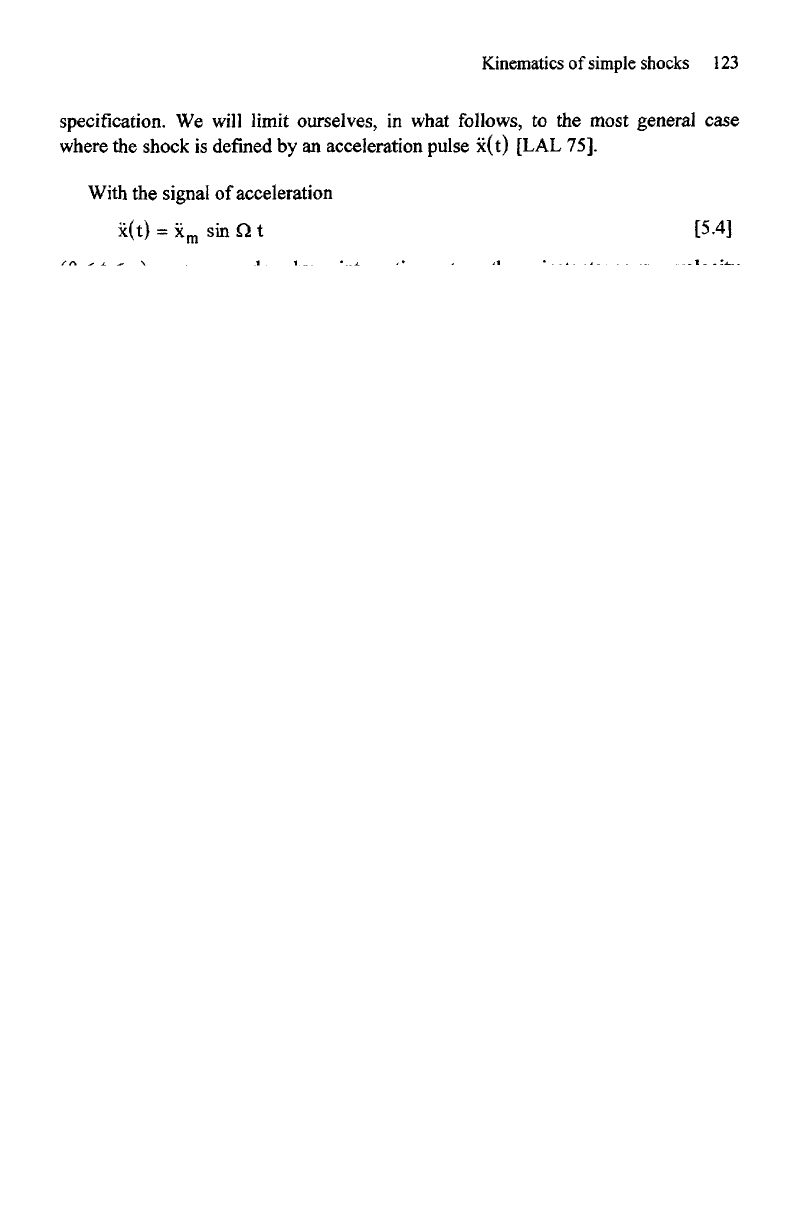
Kinematics
of
simple shocks
123
specification.
We
will limit
ourselves,
in
what follows,
to the
most
general
case
where
the
shock
is
defined
by an
acceleration
pulse
x(t) [LAL 75].
With
the
signal
of
acceleration
corresponds
by
integration
to the
instantaneous velocity
constant.
Let us
suppose that
at the
initial moment
t
= 0, the
velocity
is
equal
to
Vj:
The
constant
is
thus equal
to
and
the
velocity
to
At
the
moment
t = T of the end of the
shock,
the
velocity
v
f
has as an
expression
i.e., since
Q t = n,
The
body subjected
to
this shock thus undergoes
a
velocity change
It
is the
area
delimited
by the
curve x(t)
and the
time axis between
0 and T.
